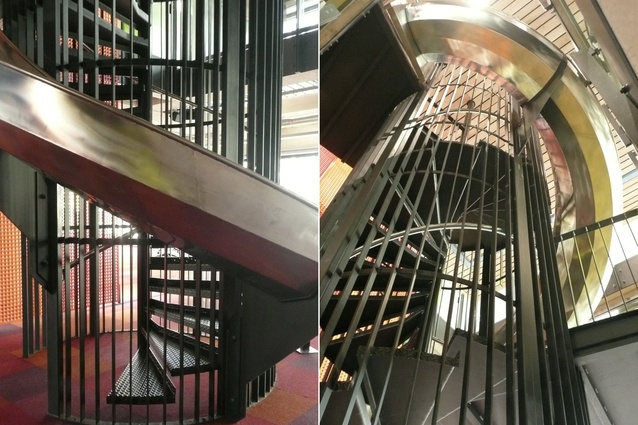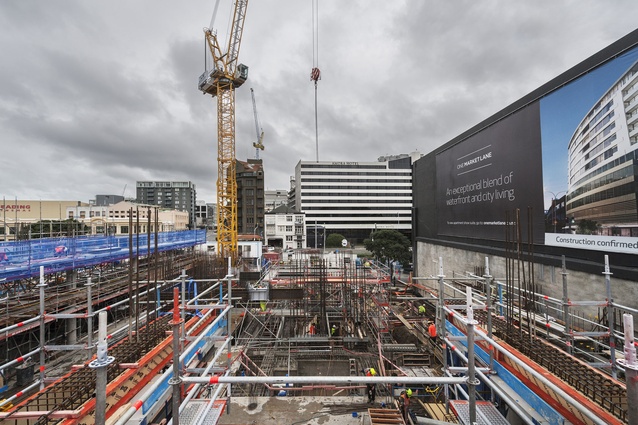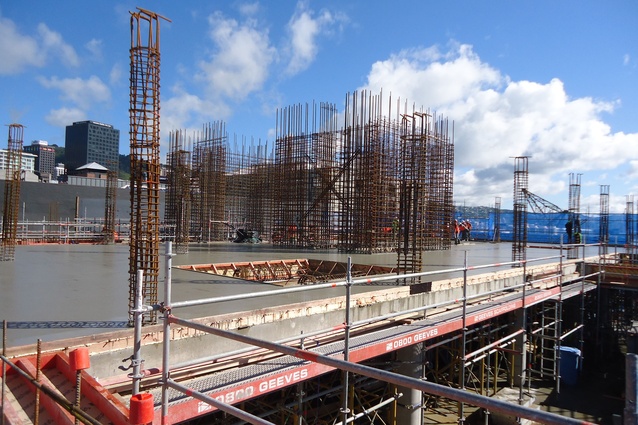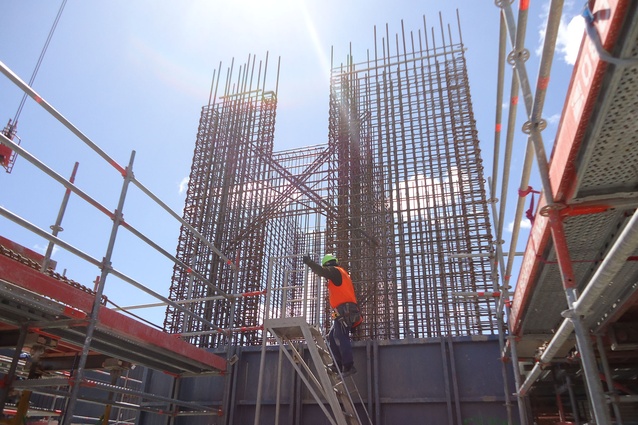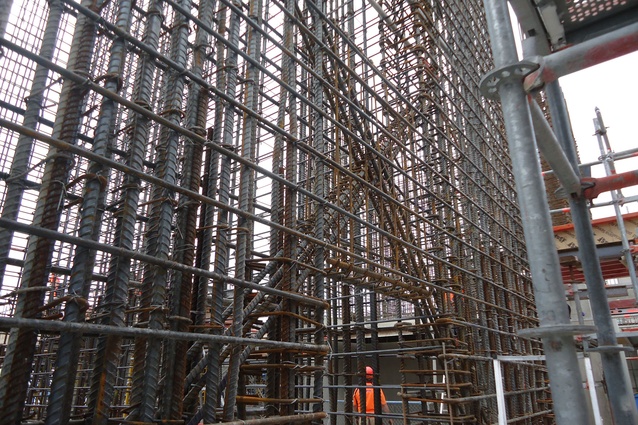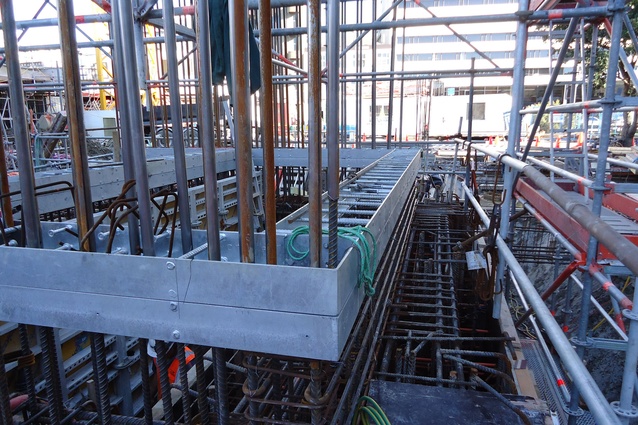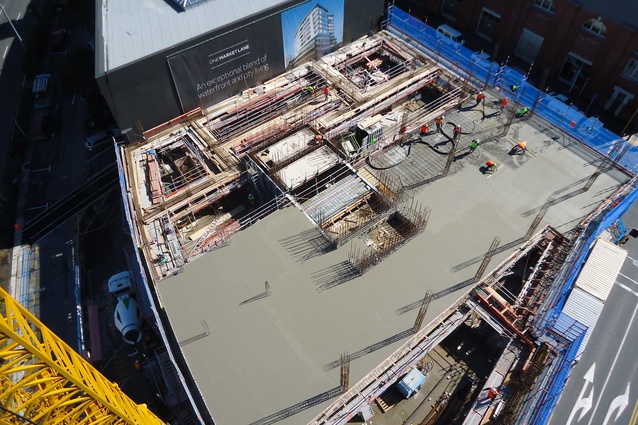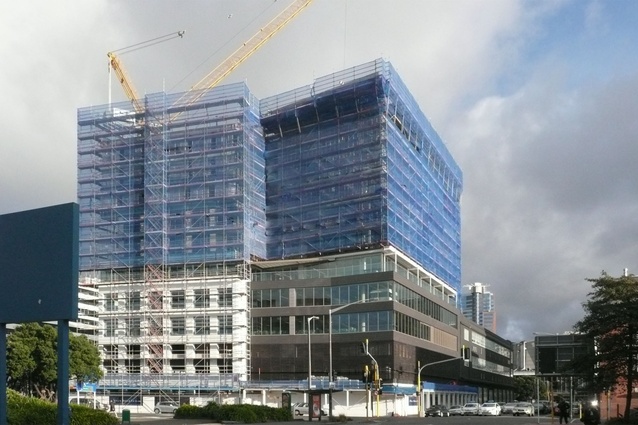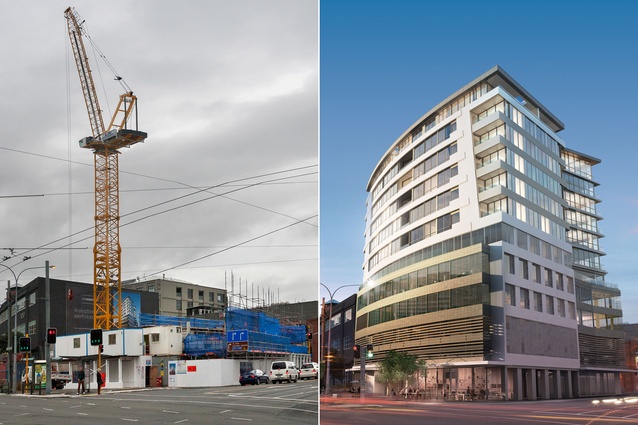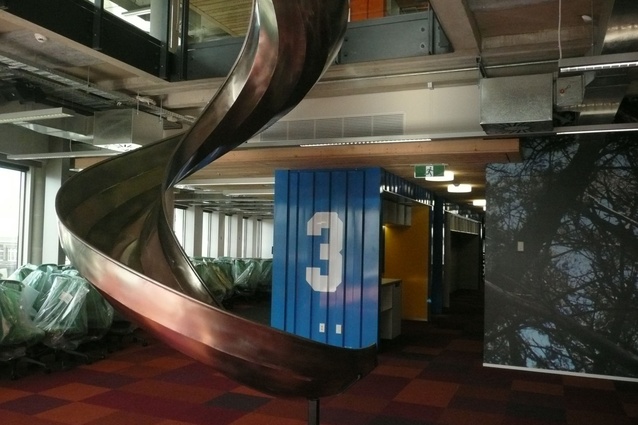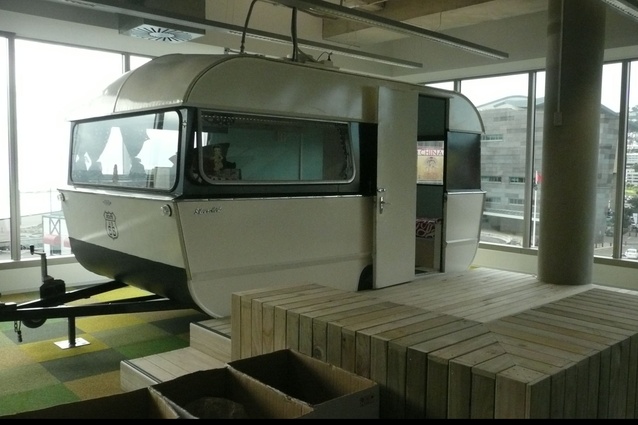Market Success
A caravan parked by a window on level two, One Market Lane, Wellington intrigues passers-by. The caravan is a meeting room, both wired and wire-lessed up to the massive high tech IT systems of Trade Me’s new office space. The internet-based company is now in residence on the commercial levels of the new mixed-use, 11-storey development thanks to the fit-out and overall build accomplished by contractor L T McGuinness. Spiral slides and “picnic rooms” with synthetic grass and clouds floating overhead, and shipping container-style kitchens painted in bright colours are other features that reflect the company’s whacky, inventive culture.
The new development is a podium (levels one to five) and tower structure (levels six to 11) that includes retail on the ground floor, two-and-a-half levels of parking, two-and-a-half levels of office accommodation, and six levels of high-end apartments, designed to make the most of superb 360-degree views of Wellington’s cityscape and harbour.
The site is on a triangular, landmark island surrounded by major city roads in the Taranaki Wharf precinct. The new development replaces the original apartment and hotel complex known as the Watermark project. The client, Willis Bond, bought the block in 2010 after the Watermark project fell through. Initially, at the north end, they earthquake strengthened and extensively refitted the distinctive ‘bull-nosed’ 1918 heritage building formerly known as the John Chambers building, now Xero House. Willis Bond also previously upgraded neighbouring heritage buildings Odlins, now the NZX building, the Free Ambulance Building and the Wellington Brewing Company building.
One Market Lane project construction manager, Matt McGuinness, said the Trade Me fit-out was unusual and fun to complete, and the building, designed by Studio Pacific Architecture and structural engineers Dunning Thornton, was cutting edge and an enjoyable challenge to build.
One Market Lane was the first significant new building to be designed in Wellington after the February 2011 earthquake in Christchurch.
Construction supervisor Sean McGuinness said the seismic performance of the building was a key feature.
“In a major earthquake the ground around it would liquefy and this building would be up on stilts. It’s one of the highest seismically performing buildings of its type with some quite innovative techniques by Dunning Thornton,” he said.
Structural engineer, Adam Thornton, said the building was designed ahead of forthcoming code changes. “We were looking to comply with recommendations from the Royal Commission and the various professional engineering bodies,” Thornton said. “No one can really define precisely what code is at the present time because there are legislative and practice changes afoot, and there will continue to be for some years to come.”
The IL2 building, designed to withstand a one-in-500-year earthquake, incorporates elements of damage avoidance. “Many Christchurch buildings were technically repairable post-quake but economically they weren’t,” Thornton said. “So clients and insurance companies are now more interested, not only in life safety (the code requirements) but also in issues of property protection.”
Innovative aspects of this building include a shear core hybrid system, which comprises both a concrete shear core and moment resisting frames.
The lower five storeys have a reinforced concrete frame. The car park on levels one and two is exposed to salt air and the concrete provides better corrosion protection. The concrete frame includes slotted beam damage avoidance technology. Similar technology was extended into the steel frame structure in the apartment levels above where there is composite flooring. Thornton said the aim was to confine stress damage to a very localised area, and to areas that are reparable, as well as avoiding damage to the floors.
“The design philosophy prior to the Christchurch quakes in some ways encouraged damage to the floors, which meant costly repairs. Structural damage to a parking building and to apartments might be similar in nature but to repair an apartment building might cost four times as much because you have to spend considerable money to expose the structure, to repair it and then return to the interior fit outs to a goodcondition.”
In slotted beams, the bottom beam bars are de-bonded and there is a slot in the face of the column to enable the bottom reinforcing in the beam to yield both in compression and in tension. That avoids elongation or dilation of the beam. “In a conventional frame the beam actually grows in length as it yields at the top and the bottom. That is what causes the floor damage. In this slotted beam technology, yielding occurs only at the bottom of the beam and that protects the floor from damage. The bottom of a beam is also easier to repair.”
Armoured hinge joints have been used at the base of the shear core and the ground floor concrete columns. These help to protect the concrete while reinforcing is yielding during major ground motion.
The building is raised on 45 piles, drilled 30 to 40 metres deep. The biggest piles are 1800mm in diameter and each reinforced with 10-tonne cages of steel. The piles, which end in 3.5 metre bells, are designed to resist lateral spreading and to hold up the building without vertical settlement during liquefaction. This is necessary because the building is on reclaimed land, which has the potential to liquefy in a major earthquake. If lateral spreading occured the ground could potentially displace towards Wellington harbour, as the ground moved towards rivers and streams in Christchurch.
The neighbours are businesses and apartment dwellers (Te Papa is also a minute’s walk away), so the contractors had to work early mornings and nights, keeping noise levels down and the site clean and safe at all times. As part of the contractor’s minimal disturbance policy the piles were drilled using an oscillation process – turning the metal casing and jacking it down at the same time. The process was less disruptive but much slower than the vibration method (a 15 degree turn at a time for the 1800mm diameter piles took three days rather than three hours) but it proved highly successful.
“To get to the ground floor we used 3000 cubic metres of concrete for the piles and 30-0 tonnes of reo. We were using 50 and 100-tonne cranes as well as a power crane, two drilling rigs and one drilling crane. We had five cranes operating at the same time,” commercial manager David Aldridge said.
And the logistics of communication between the different cranes in a small space required careful planning. “Whatever we did, we always had the next step planned,” McGuinness said. “It was heavily supervised and we had a terrific reinforcing steel team. They solved a lot of the problems on the spot along with one of our foremen. A lot of it was trial and error, using a number of techniques but by the time we got to the second floor we had found the fastest and most practical way to do it.”
He said construction presented project-specific challenges. “Structurally it was a technically difficult building to do. There were details that, not only we hadn’t done before, but that hadn’t been used in New Zealand before, such as really heavy reinforcing and a lot of moveable armoured joints. The concrete podium and the steel tower structures are almost two separate buildings layered on top of each other.”
The contractor staged the project to ensure Trade Me could move in before the rest of the building was finished, so they completed levels as they went rather than finishing the structure followed by the outside and inside. “We prefabricated a lot of the fit out in a factory we hired in Petone and brought them is as completed floor plate in panels because we didn’t have enough time to build them on site.”
Installing the three-level spiral slide with a staircase in the middle was a first. The slide was made in Plimmerton and brought in during mid-construction. “That was quite a big moment. We were working on level five and lowered it into place using two mobile cranes and our tower crane. We had to lift it in to a vertical position and lower it through the holes in the floor slabs. Then we carried in the floors and put them over the top of it,” McGuinness said.
Work is continuing on the apartments above as Trade Me settles in to their new space. This mixed-use building caters for hospitality/retail, commercial and residential functions so the claddings, window systems, services and interior details are quite different, which adds complexity to the build.
Thornton said there was a great team effort between Willis Bond, LT McGuinness, all the engineers and the architects, Studio Pacific, to achieve an impressive result. “Mixed use is always difficult to achieve. I think the building has a striking and exciting design.”
And none, as far as they know, can boast the largest internal spiral slide in New Zealand.

